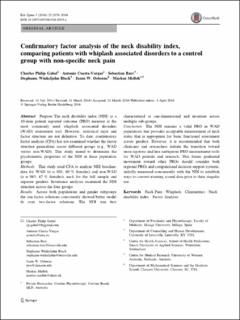Please use this identifier to cite or link to this item:
https://doi.org/10.21256/zhaw-1628Full metadata record
| DC Field | Value | Language |
|---|---|---|
| dc.contributor.author | Gabel, Charles P. | - |
| dc.contributor.author | Cuesta-Vargas, Antonio I. | - |
| dc.contributor.author | Barr, Sebastian | - |
| dc.contributor.author | Winkeljohn Black, Stephanie | - |
| dc.contributor.author | Osborne, Jason W. | - |
| dc.contributor.author | Melloh, Markus | - |
| dc.date.accessioned | 2018-02-01T13:04:08Z | - |
| dc.date.available | 2018-02-01T13:04:08Z | - |
| dc.date.issued | 2016-07 | - |
| dc.identifier.issn | 0940-6719 | de_CH |
| dc.identifier.issn | 1432-0932 | de_CH |
| dc.identifier.uri | https://digitalcollection.zhaw.ch/handle/11475/2541 | - |
| dc.description.abstract | Purpose: The neck disability index (NDI) as a 10-item patient reported outcome (PRO) measure is the most commonly used whiplash associated disorders (WAD) assessment tool. However, statistical rigor and factor structure are not definitive. To date, confirmatory factor analysis (CFA) has not examined whether the factor structure generalizes across different groups (e.g., WAD versus non-WAD). This study aimed to determine the psychometric properties of the NDI in these population groups. Methods: This study used CFA to analyze NDI baseline-data for WAD (n = 804; 69 % females) and non-WAD (n = 963; 67 % females), each for the full sample and separate genders. Invariance analyses examined the NDI structure across the four groups. Results: Across both populations and gender subgroups the one-factor solutions consistently showed better model fit over two-factor solutions. The NDI was best characterized as one-dimensional and invariant across multiple sub-groups. Conclusion: The NDI remains a valid PRO in WAD populations that provides acceptable measurement of neck status that is appropriate for basic functional assessment across genders. However, it is recommended that both clinicians and researchers initiate the transition toward more rigorous and less ambiguous PRO measurement tools for WAD patients and research. This future graduated movement toward other PROs should consider both regional PROs and computerized decision support systems, initially measured concurrently with the NDI to establish ways to convert existing scored data prior to their singular use. | de_CH |
| dc.language.iso | en | de_CH |
| dc.publisher | Springer | de_CH |
| dc.relation.ispartof | European Spine Journal | de_CH |
| dc.rights | Licence according to publishing contract | de_CH |
| dc.subject | Neck pain | de_CH |
| dc.subject | Whiplash | de_CH |
| dc.subject | Clinimetrics | de_CH |
| dc.subject | Neck disability index | de_CH |
| dc.subject | Factor analysis | de_CH |
| dc.subject.ddc | 617.5: Orthopädische Chirurgie | de_CH |
| dc.title | Confirmatory factor analysis of the neck disability index in a whiplash population indicates a one-factor model is viable | de_CH |
| dc.type | Beitrag in wissenschaftlicher Zeitschrift | de_CH |
| dcterms.type | Text | de_CH |
| zhaw.departement | Gesundheit | de_CH |
| zhaw.organisationalunit | Institut für Public Health (IPH) | de_CH |
| zhaw.publisher.place | Berlin | de_CH |
| dc.identifier.doi | 10.21256/zhaw-1628 | - |
| dc.identifier.doi | 10.1007/s00586-016-4543-z | de_CH |
| zhaw.funding.eu | No | de_CH |
| zhaw.issue | 7 | de_CH |
| zhaw.originated.zhaw | Yes | de_CH |
| zhaw.pages.end | 2086 | de_CH |
| zhaw.pages.start | 2078 | de_CH |
| zhaw.publication.status | publishedVersion | de_CH |
| zhaw.volume | 25 | de_CH |
| zhaw.publication.review | Peer review (Publikation) | de_CH |
| Appears in collections: | Publikationen Gesundheit | |
Files in This Item:
| File | Description | Size | Format | |
|---|---|---|---|---|
| Melloh_Confirmatory factor analysis of the neck disability index_The Spine Journal.pdf | 412.25 kB | Adobe PDF |  View/Open |
Show simple item record
Gabel, C. P., Cuesta-Vargas, A. I., Barr, S., Winkeljohn Black, S., Osborne, J. W., & Melloh, M. (2016). Confirmatory factor analysis of the neck disability index in a whiplash population indicates a one-factor model is viable. European Spine Journal, 25(7), 2078–2086. https://doi.org/10.21256/zhaw-1628
Gabel, C.P. et al. (2016) ‘Confirmatory factor analysis of the neck disability index in a whiplash population indicates a one-factor model is viable’, European Spine Journal, 25(7), pp. 2078–2086. Available at: https://doi.org/10.21256/zhaw-1628.
C. P. Gabel, A. I. Cuesta-Vargas, S. Barr, S. Winkeljohn Black, J. W. Osborne, and M. Melloh, “Confirmatory factor analysis of the neck disability index in a whiplash population indicates a one-factor model is viable,” European Spine Journal, vol. 25, no. 7, pp. 2078–2086, Jul. 2016, doi: 10.21256/zhaw-1628.
GABEL, Charles P., Antonio I. CUESTA-VARGAS, Sebastian BARR, Stephanie WINKELJOHN BLACK, Jason W. OSBORNE und Markus MELLOH, 2016. Confirmatory factor analysis of the neck disability index in a whiplash population indicates a one-factor model is viable. European Spine Journal. Juli 2016. Bd. 25, Nr. 7, S. 2078–2086. DOI 10.21256/zhaw-1628
Gabel, Charles P., Antonio I. Cuesta-Vargas, Sebastian Barr, Stephanie Winkeljohn Black, Jason W. Osborne, and Markus Melloh. 2016. “Confirmatory Factor Analysis of the Neck Disability Index in a Whiplash Population Indicates a One-Factor Model Is Viable.” European Spine Journal 25 (7): 2078–86. https://doi.org/10.21256/zhaw-1628.
Gabel, Charles P., et al. “Confirmatory Factor Analysis of the Neck Disability Index in a Whiplash Population Indicates a One-Factor Model Is Viable.” European Spine Journal, vol. 25, no. 7, July 2016, pp. 2078–86, https://doi.org/10.21256/zhaw-1628.
Items in DSpace are protected by copyright, with all rights reserved, unless otherwise indicated.